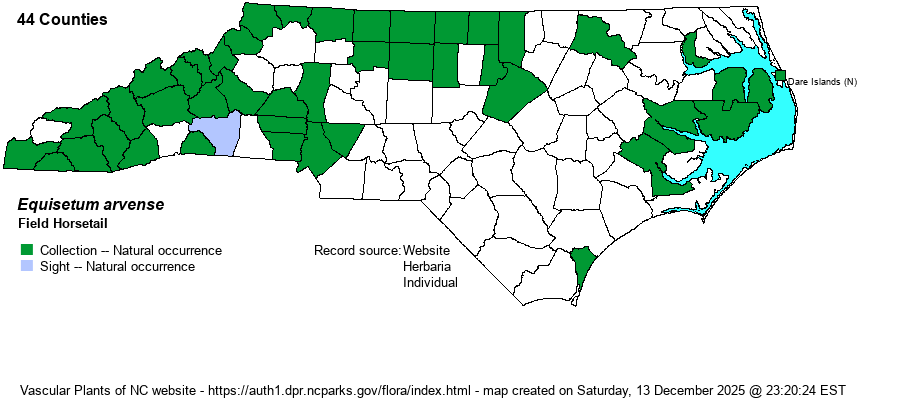| Author | L. | |
| Distribution | Throughout the Mountains; present over most of the Piedmont, and in parts of the Coastal Plain. Very scarce to absent from the southeastern Piedmont and most of the southern Coastal Plain.
This is a very widespread Northern species, ranging from Canada south to central GA, central AL, AZ, CA, and northern Mex. Circumboreal and temperate.
| |
| Abundance | Frequent to locally common in the Mountains; uncommon to infrequent in the Piedmont, except very rare to absent in the southeastern portions. Uncommon in the northern and eastern Coastal Plain, and mostly absent farther south. | |
| Habitat | This species favors damp ground, often disturbed, even in scoured areas such as stream banks. Grows in bottomland openings, damp fields, roadbanks, and along edges of railroads. | |
| Phenology | Fruits from March to May. | |
| Identification | This species has dimorphic stems. The sterile stalk is slender, quite heavily branched, and can grow to 2-3 feet tall, green in color. The branches are very slender, whorled, with many filamentous segments -- looking very bushy. The fertile stem is pinkish-flesh in color, unbranched, reaching only about 9 inches tall, and rather thick (to about 1/3-inch across). There are numerous nodes along the bare stem, at which grow numerous and narrow teeth on each sheath. The cone at the top of the fertile stem is about 3/4-inch long. This species looks similar to other species outside of NC, but completely different from the other native one, E. praeltum. The species is a familiar one in the mountains, but is less often encountered elsewhere than is E. praeltum. | |
| Taxonomic Comments | None
| |
| Other Common Name(s) | Common Horestail | |
| State Rank | S4 | |
| Global Rank | G5 | |
| State Status | | |
| US Status | | |
| USACE-agcp | FAC link |
| USACE-emp | FAC link |

